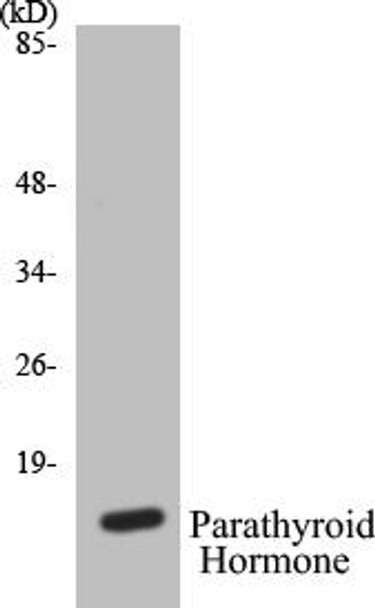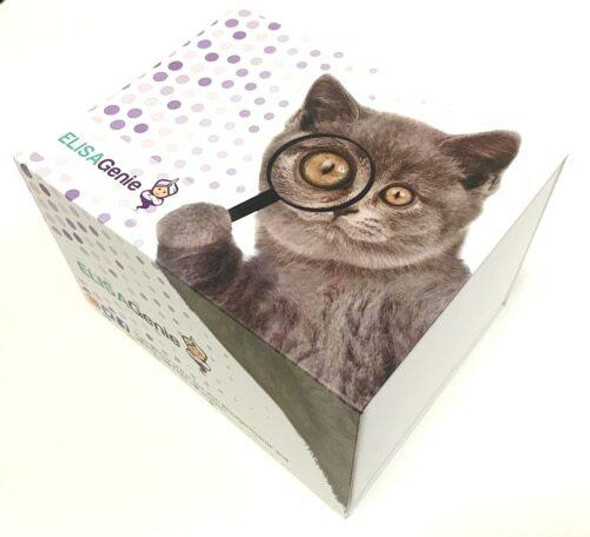Description
Parathyroid Hormone Colorimetric Cell-Based ELISA Kit
The Parathyroid Hormone Colorimetric Cell-Based ELISA Kit offered by AssayGenie is a state-of-the-art tool for accurately measuring parathyroid hormone levels in various biological samples such as serum, plasma, and cell culture supernatants. With its high sensitivity and specificity, this kit ensures precise and reproducible results, making it an essential resource for researchers across different fields.Parathyroid hormone is a critical regulator of calcium and phosphorus metabolism in the body, playing a crucial role in maintaining bone health and mineral balance. Abnormal levels of parathyroid hormone are associated with various health conditions such as hyperparathyroidism, osteoporosis, and chronic kidney disease.
By accurately measuring parathyroid hormone levels, researchers can gain valuable insights into these conditions and develop potential therapeutic interventions.Whether studying bone disorders, kidney diseases, or other related health issues, the Parathyroid Hormone Colorimetric Cell-Based ELISA Kit provides researchers with a reliable and efficient tool for their research needs. Trust AssayGenie for high-quality kits that deliver accurate and insightful results for your scientific inquiries.
| Product Name: | Parathyroid Hormone Colorimetric Cell-Based ELISA Kit |
| Product Code: | CBCAB00801 |
| ELISA Type: | Cell-Based |
| Target: | Parathyroid Hormone |
| Reactivity: | Human |
| Dynamic Range: | > 5000 Cells |
| Detection Method: | Colorimetric 450 nmStorage/Stability:4°C/6 Months |
| Format: | 96-Well Microplate |
The Parathyroid Hormone Colorimetric Cell-Based ELISA Kit is a convenient, lysate-free, high throughput and sensitive assay kit that can detect Parathyroid Hormone protein expression profile in cells. The kit can be used for measuring the relative amounts of Parathyroid Hormone in cultured cells as well as screening for the effects that various treatments, inhibitors (ie siRNA or chemicals), or activators have on Parathyroid Hormone.
Qualitative determination of Parathyroid Hormone concentration is achieved by an indirect ELISA format. In essence, Parathyroid Hormone is captured by Parathyroid Hormone-specific primary antibodies while the HRP-conjugated secondary antibodies bind the Fc region of the primary antibody. Through this binding, the HRP enzyme conjugated to the secondary antibody can catalyze a colorimetric reaction upon substrate addition. Due to the qualitative nature of the Cell-Based ELISA, multiple normalization methods are needed:
| 1. | A monoclonal antibody specific for human GAPDH is included to serve as an internal positive control in normalizing the target absorbance values. |
| 2. | Following the colorimetric measurement of HRP activity via substrate addition, the Crystal Violet whole-cell staining method may be used to determine cell density. After staining, the results can be analysed by normalizing the absorbance values to cell amounts, by which the plating difference can be adjusted. |
| Database Information: | Gene ID: 5741, UniProt ID: P01270, OMIM: 168450, Unigene: Hs.37045 |
| Gene Symbol: | PTH |
| Sub Type: | None |
| UniProt Protein Function: | PTH: PTH elevates calcium level by dissolving the salts in bone and preventing their renal excretion. Stimulates [1-14C]-2- deoxy-D-glucose (2DG) transport and glycogen synthesis in osteoblastic cells. Defects in PTH are a cause of familial isolated hypoparathyroidism (FIH); also called autosomal dominant hypoparathyroidism or autosomal dominant hypocalcemia. FIH is characterized by hypocalcemia and hyperphosphatemia due to inadequate secretion of parathyroid hormone. Symptoms are seizures, tetany and cramps. FIH exist both as autosomal dominant and recessive forms of hypoparathyroidism. Belongs to the parathyroid hormone family. |
| UniProt Protein Details: | Protein type:Secreted, signal peptide; Secreted; Hormone; Apoptosis Chromosomal Location of Human Ortholog: 11p15.3-p15.1 Cellular Component: extracellular space; extracellular region Molecular Function:RNA polymerase II transcription factor activity, enhancer binding; type 1 parathyroid hormone receptor binding; parathyroid hormone receptor binding; peptide hormone receptor binding; hormone activity Biological Process: response to drug; transcription from RNA polymerase II promoter; positive regulation of signal transduction; induction of apoptosis by hormones; positive regulation of glycogen biosynthetic process; negative regulation of transcription from RNA polymerase II promoter; positive regulation of bone mineralization; G-protein signaling, adenylate cyclase activating pathway; Rho protein signal transduction; cellular calcium ion homeostasis; positive regulation of glucose import; G-protein coupled receptor protein signaling pathway; cAMP metabolic process; response to vitamin D; response to cadmium ion; response to ethanol; cell-cell signaling; regulation of gene expression; positive regulation of cAMP biosynthetic process; response to lead ion; positive regulation of transcription from RNA polymerase II promoter; skeletal development; bone resorption Disease: Hypoparathyroidism, Familial Isolated |
| NCBI Summary: | The protein encoded by this gene is a hormone secreted by parathyroid cells. This hormone elevates blood Ca2+ level by dissolving the salts in bone and preventing their renal excretion. Defects in this gene are a cause of familial isolated hypoparathyroidism (FIH). [provided by RefSeq, Jul 2008] |
| UniProt Code: | P01270 |
| NCBI GenInfo Identifier: | 131547 |
| NCBI Gene ID: | 5741 |
| NCBI Accession: | P01270.1 |
| UniProt Secondary Accession: | P01270,Q4VB48, Q9UD38, |
| UniProt Related Accession: | P01270 |
| Molecular Weight: | 12,861 Da |
| NCBI Full Name: | Parathyroid hormone |
| NCBI Synonym Full Names: | parathyroid hormone |
| NCBI Official Symbol: | PTH |
| NCBI Official Synonym Symbols: | PTH1 |
| NCBI Protein Information: | parathyroid hormone; parathyrin; prepro-PTH; parathormone; parathyroid hormone 1; preproparathyroid hormone |
| UniProt Protein Name: | Parathyroid hormone |
| UniProt Synonym Protein Names: | Parathormone; Parathyrin |
| Protein Family: | Parathyroid hormone |
| UniProt Gene Name: | PTH |
| UniProt Entry Name: | PTHY_HUMAN |
| Component | Quantity |
| 96-Well Cell Culture Clear-Bottom Microplate | 2 plates |
| 10X TBS | 24 mL |
| Quenching Buffer | 24 mL |
| Blocking Buffer | 50 mL |
| 15X Wash Buffer | 50 mL |
| Primary Antibody Diluent | 12 mL |
| 100x Anti-Phospho Target Antibody | 60 µL |
| 100x Anti-Target Antibody | 60 µL |
| Anti-GAPDH Antibody | 60 µL |
| HRP-Conjugated Anti-Rabbit IgG Antibody | 12 mL |
| HRP-Conjugated Anti-Mouse IgG Antibody | 12 mL |
| SDS Solution | 12 mL |
| Stop Solution | 24 mL |
| Ready-to-Use Substrate | 12 mL |
| Crystal Violet Solution | 12 mL |
| Adhesive Plate Seals | 2 seals |
The following materials and/or equipment are NOT provided in this kit but are necessary to successfully conduct the experiment:
- Microplate reader able to measure absorbance at 450 nm and/or 595 nm for Crystal Violet Cell Staining (Optional)
- Micropipettes with capability of measuring volumes ranging from 1 µL to 1 ml
- 37% formaldehyde (Sigma Cat# F-8775) or formaldehyde from other sources
- Squirt bottle, manifold dispenser, multichannel pipette reservoir or automated microplate washer
- Graph paper or computer software capable of generating or displaying logarithmic functions
- Absorbent papers or vacuum aspirator
- Test tubes or microfuge tubes capable of storing ≥1 ml
- Poly-L-Lysine (Sigma Cat# P4832 for suspension cells)
- Orbital shaker (optional)
- Deionized or sterile water
*Note: Protocols are specific to each batch/lot. For the correct instructions please follow the protocol included in your kit.
| Step | Procedure |
| 1. | Seed 200 µL of 20,000 adherent cells in culture medium in each well of a 96-well plate. The plates included in the kit are sterile and treated for cell culture. For suspension cells and loosely attached cells, coat the plates with 100 µL of 10 µg/ml Poly-L-Lysine (not included) to each well of a 96-well plate for 30 minutes at 37°C prior to adding cells. |
| 2. | Incubate the cells for overnight at 37°C, 5% CO2. |
| 3. | Treat the cells as desired. |
| 4. | Remove the cell culture medium and rinse with 200 µL of 1x TBS, twice. |
| 5. | Fix the cells by incubating with 100 µL of Fixing Solution for 20 minutes at room temperature. The 4% formaldehyde is used for adherent cells and 8% formaldehyde is used for suspension cells and loosely attached cells. |
| 6. | Remove the Fixing Solution and wash the plate 3 times with 200 µL 1x Wash Buffer for five minutes each time with gentle shaking on the orbital shaker. The plate can be stored at 4°C for a week. |
| 7. | Add 100 µL of Quenching Buffer and incubate for 20 minutes at room temperature. |
| 8. | Wash the plate 3 times with 1x Wash Buffer for 5 minutes each time. |
| 9. | Add 200 µL of Blocking Buffer and incubate for 1 hour at room temperature. |
| 10. | Wash 3 times with 200 µL of 1x Wash Buffer for 5 minutes each time. |
| 11. | Add 50 µL of 1x primary antibodies (Anti-Parathyroid Hormone Antibody and/or Anti-GAPDH Antibody) to the corresponding wells, cover with Parafilm and incubate for 16 hours (overnight) at 4°C. If the target expression is known to be high, incubate for 2 hours at room temperature. |
| 12. | Wash 3 times with 200 µL of 1x Wash Buffer for 5 minutes each time. |
| 13. | Add 50 µL of 1x secondary antibodies (HRP-Conjugated AntiRabbit IgG Antibody or HRP-Conjugated Anti-Mouse IgG Antibody) to corresponding wells and incubate for 1.5 hours at room temperature. |
| 14. | Wash 3 times with 200 µL of 1x Wash Buffer for 5 minutes each time. |
| 15. | Add 50 µL of Ready-to-Use Substrate to each well and incubate for 30 minutes at room temperature in the dark. |
| 16. | Add 50 µL of Stop Solution to each well and read OD at 450 nm immediately using the microplate reader. |
(Additional Crystal Violet staining may be performed if desired – details of this may be found in the kit technical manual.)






